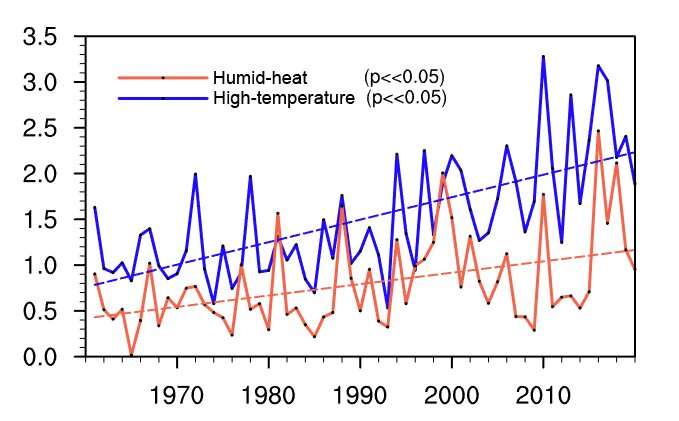This article has been reviewed according to Science X's editorial process and policies. Editors have highlighted the following attributes while ensuring the content's credibility:
fact-checked
trusted source
proofread
More extreme-heat occurrences related to humidity in China: Study

One of the main risks posed by climate change is exceeding the thermal limits of the human body. In hot environments, evaporation is considered to be the primary means by which human bodies cool down. However, atmospheric humidity is a crucial factor affecting the efficiency of evaporation, making the combination of hot and humid conditions more physiologically stressful than extreme dry-temperature conditions.
Besides the human health impacts, the occurrence of extreme-heat events also has severe socioeconomic impacts. For example, the record-breaking extreme heat event in Europe in 2003, the rare extreme heat wave in Russia in 2010, and a long-duration heat wave in southern China in 2013, aside from the thousands of human casualties, all caused billions of dollars in economic losses.
The co-occurrence of day and night heat extremes has attracted much attention in China because, with its vast population and many laborers engaged in outdoor work, the recent rapid increases in air temperature that have resulted in more frequent and intense heat waves pose particularly dangerous conditions across most of the country.
With this in mind, the research group of Prof. Huopo Chen from the Institute of Atmospheric Physics, Chinese Academy of Sciences, Beijing, China, characterized and compared extreme day–night compound humid-heat/high-temperature events in China as well as the associated impacts. The results have been published recently in Atmospheric and Oceanic Science Letters.
Against the background of global warming, significant increasing trends in the frequency of such extreme events are captured nationwide, but with much stronger trends detected in northern and western China. According to this study, the anomalies of humidity play a more important role than those of temperature in the occurrence of extreme compound humid-heat events in most parts of China, but particularly in eastern regions.
Since 1961, the human population and land areas of China have experienced strongly increasing compound heat extremes, with a faster rate of exposure to extreme compound humid-heat events than to extreme compound high-temperature events.
"Understanding the nature of humidity and limiting its occurrence may be an important step in dealing with regional changes in heat stress in the future," concludes Prof. Chen.
More information: Wenyue He et al, More extreme-heat occurrences related to humidity in China, Atmospheric and Oceanic Science Letters (2023). DOI: 10.1016/j.aosl.2023.100391
Provided by Chinese Academy of Sciences



















